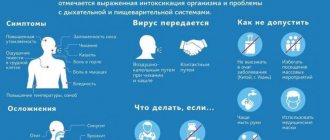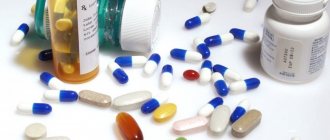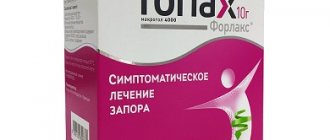Release form and composition
The dosage form of Glidiab MV is modified-release tablets: flat-cylindrical, white with a creamy tint or white, with a chamfer, marbling is acceptable (10 pcs. in blister packs, 3 or 6 packs in a cardboard pack).
Composition of 1 tablet:
- active substance: gliclazide – 30 mg;
- auxiliary components: microcrystalline cellulose – 123 mg; hypromellose – 44 mg; Magnesium stearate – 2 mg; colloidal silicon dioxide – 1 mg.
Glidiab MV tablet with modified release 30 mg No. 60 48205
Description
Glidiab® MB modified release tablets 30 mg; contour packaging 10, cardboard pack 6; EAN code: 4601969005073; No. LS-000002, 2010-02-25 from Akrikhin (Russia) Latin name Glidiab MV Active ingredient Gliclazide* (Gliclazidum) ATC: A10BB09 Gliclazide Pharmacological group Hypoglycemic synthetic and other drugs Nosological classification (ICD-10) E11 Non-insulin-dependent diabetes mellitus Indications Mellitus type 2 diabetes, monotherapy and in combination with insulin or other oral hypoglycemic drugs. Contraindications Hypersensitivity, type 1 diabetes mellitus, incl. juvenile, ketoacidosis, diabetic (with ketoacidosis) and hyperosmolar coma, extensive trauma and burns, liver failure and severe forms of renal failure, hypo- and hyperthyroidism, pregnancy, breastfeeding. Use during pregnancy and breastfeeding Contraindicated during pregnancy. Breastfeeding should be stopped during treatment. Side effects From the gastrointestinal tract: very rarely - dyspeptic symptoms (nausea, vomiting, abdominal pain), extremely rarely - jaundice. From the cardiovascular system and blood: reversible cytopenia, eosinophilia, anemia. From the skin: rarely - allergic skin reactions, photosensitivity. Metabolism: hypoglycemia. From the nervous system and sensory organs: weakness, headache, dizziness, changes in taste. Precautions During the dose selection period, especially when combined with insulin therapy, it is necessary to determine the sugar profile and glycemic dynamics, and then regular monitoring of blood glucose levels is indicated. To prevent hypoglycemia, it is necessary to clearly time the drug intake with meals, avoid fasting and completely stop drinking alcohol. Concomitant use of beta-blockers may mask the symptoms of hypoglycemia. It is recommended to follow a low-calorie, low-carbohydrate diet. Use with caution while working for vehicle drivers and people whose profession involves increased concentration. Storage conditions for Glidiab® MV: In a dry place, protected from light, at a temperature not exceeding 25 °C. Keep out of the reach of children. The shelf life of Glidiab® MB is 2 years. Do not use after the expiration date stated on the package. 2000-2015. Register of Medicines of Russia The database is intended for healthcare professionals. Commercial use of materials is not permitted.
Possible product names
- Glidiab MV tab. 30 mg. No. 60
- GLIDIAB MV 30 MG TAB No. 60
- GLIDIAB MV 0.03 N60 TABLE WITH MODIF RELEASE
- GLYDIAB MV TABLE. 30 MG X60
- GLYDIAB TAB. 80MG No. 60
- Glidiab MV 30 mg Tab. with modified vysv. Х60/!until 12.08/
- (Glidiab MV) Glidiab MV tab. 30 mg. No. 60
- GLIDIAB MV 30 MG TAB. No. 60
Pharmacological properties
Pharmacodynamics
Glidiab MB is one of the oral hypoglycemic drugs. The active substance is gliclazide, a second generation sulfonylurea derivative.
Main effects of gliclazide:
- stimulation of insulin secretion by pancreatic β-cells;
- increased sensitivity of peripheral tissues to insulin;
- restoration of the early peak of insulin secretion (which distinguishes Glidiab MB from other sulfonylurea derivatives, which have a greater effect during the second stage of secretion);
- reducing the interval from the moment of food intake to the onset of insulin secretion;
- stimulating the activity of intracellular enzymes - muscle glycogen synthetase;
- enhancing the insulin secretory effect of glucose;
- reduction of postprandial increase in glucose levels;
- improvement of microcirculation, which manifests itself as a decrease in platelet adhesion and aggregation, normalization of vascular permeability, preventing the development of atherosclerosis and microthrombosis, restoration of the processes of physiological parietal fibrinolysis;
- slowing down the development of diabetic retinopathy at the non-proliferative stage; against the background of long-term use for diabetic nephropathy leads to a significant decrease in the severity of proteinuria;
- decreased sensitivity of vascular receptors to adrenaline.
Glidiab MB does not lead to weight gain, since it has a predominant effect on the early peak of insulin secretion and does not cause hyperinsulinemia. In obese patients, when following an appropriate diet, therapy promotes weight loss.
Pharmacokinetics
Gliclazide after oral administration is almost completely absorbed from the gastrointestinal tract. Its plasma concentration increases gradually and reaches a maximum within 6–12 hours. Food intake does not affect the absorption of the substance.
When taken daily, a single dose of Glidiab MB provides effective therapeutic plasma concentrations of gliclazide for 24 hours.
Plasma protein binding is approximately 95%.
Metabolism occurs in the liver with the subsequent formation of inactive metabolites.
T1/2 (half-life) is approximately 16 hours. It is excreted mainly by the kidneys in the form of metabolites; about 1% of the substance is excreted unchanged in the urine.
Pharmacokinetics
Suction
After oral administration, it is almost completely absorbed from the gastrointestinal tract. The concentration of the active substance in plasma increases gradually, reaching a maximum 6-12 hours after taking the drug. Eating does not affect absorption.
Due to the peculiarities of the dosage form, daily administration of a single dose of the drug provides an effective therapeutic concentration of gliclazide in plasma for 24 hours.
Distribution
Plasma protein binding is approximately 95%.
Metabolism
Metabolized in the liver to form inactive metabolites.
Removal
T1/2 is approximately 16 hours. It is excreted mainly by the kidneys in the form of metabolites and about 1% of the drug is excreted unchanged in the urine.
Pharmacokinetics in special clinical situations
Elderly patients do not experience any significant clinical changes in pharmacokinetics.
Contraindications
Absolute:
- type 1 diabetes mellitus;
- diabetic ketoacidosis;
- diabetic coma/precoma;
- conditions that are accompanied by impaired absorption of food, the occurrence of hypoglycemia (infectious diseases);
- hyperosmolar coma;
- gastric paresis;
- leukopenia;
- severe liver/renal failure;
- intestinal obstruction;
- extensive surgical interventions, extensive injuries, burns and other conditions that require insulin therapy;
- combination therapy with miconazole, danazol or phenylbutazone;
- age under 18 years;
- pregnancy and breastfeeding;
- individual intolerance to any of the components of the drug, as well as sulfonamides and other sulfonylurea derivatives.
Relative (Glidiab MV is prescribed under medical supervision):
- febrile syndrome;
- alcoholism;
- unbalanced/irregular diet;
- pituitary/adrenal insufficiency;
- severe diseases of the cardiovascular system (including atherosclerosis, coronary heart disease);
- renal/liver failure;
- hypopituitarism;
- glucose-6-phosphate dehydrogenase deficiency;
- long-term use of glucocorticosteroids;
- diseases of the thyroid gland that impair its function;
- elderly age.
Contraindications to the use of GLIDIAB® MB
— diabetes mellitus type 1;
- diabetic ketoacidosis;
- diabetic precoma, diabetic coma;
- hyperosmolar coma;
- severe liver and/or kidney failure;
- extensive surgical interventions, extensive burns, injuries and other conditions requiring insulin therapy;
- intestinal obstruction;
- gastric paresis;
- conditions accompanied by impaired absorption of food, the development of hypoglycemia (infectious diseases);
- leukopenia;
- pregnancy;
- lactation period (breastfeeding);
- hypersensitivity to the components of the drug.
Carefully _
the drug should be used (the need for more careful monitoring and dose selection) in patients with febrile syndrome, diseases of the thyroid gland (with impaired function), and alcoholism.
Instructions for use of Glidiab MV: method and dosage
Glidiab MB is taken orally, 1 time per day with breakfast.
The dose of the drug is selected by the doctor individually based on the clinical manifestations of the disease, fasting glucose levels and 2 hours after meals.
The initial daily dose is 1 tablet. In the future, if necessary, the dose is increased with a break of at least 2 weeks. The maximum dose is 4 tablets per day.
It is possible to switch from Glidiab to Glidiab MB in a daily dose of 1–4 tablets.
Therapy can be combined with other hypoglycemic agents: biguanides, insulin or alpha-glucosidase inhibitors.
Dosage regimen
The dose of the drug should be selected individually depending on the clinical manifestations of the disease, fasting glucose levels and 2 hours after meals.
Initial daily dose (including for elderly patients over 65 years of age
) is 30 mg (1 tablet). In the future, if necessary, the dose of the drug is increased at intervals of at least 2 weeks. The maximum daily dose is 120 mg (4 tablets). The drug is taken orally 1 time/day. in the morning during breakfast.
Glidiab® MB can be replaced with Glidiab® in doses of 1 to 4 tablets/day.
Glidiab® MB can be used in combination with other hypoglycemic agents: biguanides, alpha-glucosidase inhibitors or insulin.
Patients with mild to moderate renal impairment (creatinine clearance from 15 to 80 ml/min)
the drug is prescribed in the same doses.
Side effects
- endocrine system: hypoglycemia (in cases of violation of the dosage regimen and inadequate diet) - headache, feeling of hunger, helplessness and fatigue, sweating, severe weakness, inattention, aggressiveness, irritability, anxiety, convulsions, shallow breathing, loss of consciousness, delayed reaction, inability concentration, visual impairment, depression, aphasia, tremor, sensory disturbances, dizziness, bradycardia, loss of self-control, delirium, hypersomnia;
- hematopoietic system: thrombocytopenia, anemia, leukopenia;
- digestive system: dyspepsia (manifests in the form of nausea, diarrhea, feeling of heaviness in the epigastrium), anorexia (its severity decreases when taking Glidiab MB simultaneously with food), liver dysfunction (manifests in the form of increased activity of liver transaminases, cholestatic jaundice);
- allergic reactions: itching, maculopapular rash, urticaria.
special instructions
During therapy, hypoglycemia may develop, sometimes in a prolonged/severe form (hospitalization and intravenous administration of dextrose solution may be required for several days).
The use of Glidiab MB is only possible if the patient eats regularly, including breakfast. It is very important to ensure that you maintain a sufficient intake of carbohydrates from food, which helps reduce the likelihood of hypoglycemia. In most cases, the development of hypoglycemia occurs when following a low-calorie diet, after drinking alcohol and performing vigorous/prolonged exercise, as well as while taking several hypoglycemic drugs at the same time.
Symptoms of hypoglycemia usually go away after eating a carbohydrate-rich meal (sweet substitutes do not help eliminate symptoms). Based on experience with other sulfonylureas, it must be taken into account that despite the initial effective relief of this condition, hypoglycemia may recur. If the symptoms are pronounced or last for a long time, patients require emergency medical care, including hospitalization, even with a temporary improvement in their condition after eating a carbohydrate-rich meal.
To reduce the risk of hypoglycemia, careful selection of drugs and regimens for their use is required, and the patient should be informed about the features of therapy.
An increased risk of hypoglycemia is observed in the following cases:
- inability/refusal of the patient (especially elderly patients) to comply with doctor’s orders and control their condition;
- irregular/insufficient nutrition, skipping meals, changing diet and fasting;
- imbalance between the amount of carbohydrates taken and physical activity;
- thyroid diseases, adrenal/pituitary insufficiency and some other endocrine disorders;
- overdose of Glidiab MV;
- severe liver failure;
- renal failure;
- combined use with certain medications.
In patients with glucose-6-phosphate dehydrogenase deficiency, Glidiab MB can lead to the development of hemolytic anemia (before prescribing the drug, the possibility of using a hypoglycemic drug belonging to another group should be assessed).
While taking Glidiab MB, glycemic control may be weakened in the following cases: injury, fever, infectious diseases or major surgical procedures (it may be necessary to discontinue the drug and switch to insulin therapy).
After a long period of treatment in many patients, the effectiveness of Glidiab MB may decrease, which is likely due to the progression of the underlying disease or a decrease in the therapeutic response to the drug. This phenomenon is secondary drug resistance; it must be distinguished from primary resistance, in which therapy does not produce the expected clinical effect from the moment of prescription. Before diagnosing secondary drug resistance, patient compliance with the prescribed diet and the adequacy of dose selection should be assessed.
To assess glycemic control, it is recommended to regularly measure glycosylated hemoglobin and fasting blood glucose. Regular self-monitoring of blood glucose concentrations is also advisable.
Impact on the ability to drive vehicles and complex mechanisms
When driving vehicles, patients should take into account the possibility of developing hypoglycemia.
Use of Glidiab in complex therapy of type 2 diabetes mellitus
WITH
Diabetes mellitus is one of the most common endocrine diseases, representing a significant problem for national health services due to the development of vascular complications of diabetes, which cause early disability and high mortality.
Of the total number of diabetic patients, about 90% are patients suffering from type 2 diabetes mellitus
.
The main role in the mechanisms of pathogenesis of vascular complications of diabetes mellitus belongs to hyperglycemia, and in type 2 diabetes mellitus, lipid metabolism disorders.
The European Bureau of the International Federation of Diabetes and the WHO European Bureau in 1998 proposed criteria for metabolic compensation in patients with type 2 diabetes, which are presented in Table 1.
In type 2 diabetes mellitus, carbohydrate metabolism disorders are combined with pronounced changes in lipid metabolism. In this regard, when considering compensation of metabolic processes, one should take into account not only the glucose content in the blood plasma, but also indicators of lipid metabolism, which to one degree or another correlate with the risk of developing vascular complications of diabetes (Table 2).
The adequacy of diabetes therapy remains the most pressing issue, since it has been established that hyperglycemia is the trigger for many pathogenetic mechanisms that contribute to the development of vascular complications. Strict compensation for diabetes, i.e. By maintaining a normal (or close to normal) blood glucose concentration for a long time, it is possible to delay or delay the development of late complications of diabetes mellitus.
Treatment of type 2 diabetes mellitus is complex and includes diet, dosed physical activity, patient education and self-control of diabetes, drug therapy, prevention and treatment of late complications of diabetes mellitus.
For drug therapy of patients with type 2 diabetes, drugs with different mechanisms of action are used:
drugs that reduce the absorption of carbohydrates in the gastrointestinal tract (acarbose, etc.); biguanides (metformin); sulfonylurea drugs that stimulate insulin secretion, which include 2nd generation drugs: glibenclamide, glipizide, gliclazide (Glidiab), gliquidone and 3rd generation sulfonylurea drugs; short-acting drugs or prandial glucose regulators, which are derivatives of amino acids - repaglinide and nateglinide. In cases where it is not possible to achieve compensation for diabetes mellitus with the help of oral hypoglycemic drugs (in patients with type 2 diabetes mellitus with a pronounced defect of b-cells of the pancreatic islets), the use of combination therapy (oral hypoglycemic therapy + insulin therapy, more often with drugs of medium duration of action) is recommended at night or 2 times a day).
The purpose of the study was to assess the effectiveness, safety and tolerability of the drug Glidiab.
(pharmaceutical), registered with the Ministry of Health of the Russian Federation (P No. 011468/01–1999), its effect on the state of carbohydrate and lipid metabolism, lipid peroxidation, the state of the antioxidant system and insulin resistance in patients with type 2 diabetes mellitus. As a control or comparison group, we formed a group of patients suffering from type 2 diabetes mellitus, in whom the effect of diet therapy on the listed indicators was studied.
Material and methods
We examined 22 patients with type 2 diabetes mellitus (18 women and 4 men), average age 60.3 years, average disease duration 6.4 years. The duration of treatment with Glidiab was at least 12 weeks. The dose of the drug was selected individually depending on the patient’s weight and fasting and postprandial glucose levels during the initial examination. Dynamic monitoring of glycemic levels was carried out every 14 days, according to which, if necessary, therapeutic doses of the drug were adjusted. All observed patients had vascular complications of varying severity.
The second group of subjects included 30 patients (21 women and 9 men) with type 2 diabetes mellitus who were on diet therapy for 3 months. Age – from 42 to 70 years (average 58.77±8.86 years). The duration of the disease is from 1 month to 5 years. The absence of drug glucose-lowering therapy was additional evidence of the presence of a mild form of type 2 diabetes mellitus.
The effectiveness of the clinical use of the drug Glidiab was assessed by the dynamics of compensation of diabetes mellitus, for which the content of glycosylated hemoglobin was determined (before the start of insulin therapy and after 3 months of continuous treatment), by the level of glycemia on an empty stomach and two hours after meals, the frequency of cases of ketoacidosis and hypoglycemic conditions , as well as the content of immunoreactive insulin (IRI) and C-peptide in the blood serum of patients.
To establish the coefficient of insulin resistance, the level of immunoreactive insulin was determined in all patients. To assess the severity of hyperinsulinemia, a study of the amount of C-peptide was carried out. The severity of insulin resistance was determined by the index or coefficient of insulin resistance (IRI), determined
according to the formula = (fasting glycemia * IRI) / 25
In addition, the effect of Glidiab on the state of lipid metabolism was studied, for which the content of total cholesterol, triglycerides, low- and high-density lipoprotein cholesterol in the blood serum was determined (both before and after 3 months of Glidiab therapy). We judged the safety of Glidiab use by the content of creatinine, urea, liver transaminases (AST and ALT), potassium, and sodium in the blood serum, determined before and after the end of treatment.
The hemocoagulation potential of the blood was assessed using thromboelastography indicators (r, k, ma, t, S, C, E). In platelet-poor blood plasma, fibrinogen concentrations were determined using the C1au88 method, the content of soluble fibrin-monomer complexes (SFMC), fibrinolysis activity using the euglobulin lysis method, and the values of activated partial thromboplastin time (APTT), activated recalcification time (AVR), and thrombin time ( PTV) using a coagulometer (Schnitger und Gross, Germany). Kits (Moscow) were used in the work.
The effect of Glidiab on lipid peroxidation (LPO) and the state of the body's antioxidant system was assessed based on the levels of malondialdehyde, superoxide dismutase and glutathione peroxidase levels before and at the end of the observed period.
Tolerability of treatment with Glidiab produced by pharmaceutical manufacturers was assessed by the presence of the frequency of adverse events and adverse reactions. The safety of using this drug was determined by the frequency of episodes of hypoglycemia, the frequency of allergic reactions, as well as by biochemical and general blood and urine tests.
Results and discussion
Glidiab is a hypoglycemic drug from the group of second-generation sulfonylurea derivatives - gliclazide, which has been used for decades in the treatment of type 2 diabetes mellitus. Gliclazide (Glidiab) is derived from the combination of a sulfonylurea radical and a nitrogen-containing heterocyclic ring with an intra-ring bridge. This is a chemical substance that, in addition to its sugar-lowering effect, has a pronounced effect on hematological parameters, rheological properties of blood, the hemostatic system and microcirculation. Gliclazide (Glidiab) is completely absorbed from the gastrointestinal tract. Its maximum concentration in the blood is detected 2–6 hours after taking the drug, its half-life in circulation is 6–15 hours, and the duration of the effect is 10–15 hours. The therapeutic dose of gliclazide (Glidiab) is 40–320 mg/day. Glidiaba tablet contains 80 mg of gliclazide. Metabolism of gliclazide occurs in the liver with the formation of 7–8 metabolites that do not have hypoglycemic activity. The main metabolite of gliclazide (Glidiab), a carboxylic acid derivative, has an inhibitory effect on platelet aggregation and, apparently, on other vascular effects of gliclazide. About 65% of gliclazide (Glidiab) is excreted in the form of metabolites in the urine and 12–20% through the gastrointestinal tract. The main effect of Glidiab on the state of carbohydrate metabolism, like other representatives of sulfonylurea drugs, is due to the stimulation of insulin secretion by the islet apparatus of the pancreas.
Gliclazide (Glidiab) is known to restore the first peak of insulin secretion in patients with type 2 diabetes, promoting more physiological insulin secretion. In addition, Glidiab increases the sensitivity of peripheral tissues to insulin. There is evidence that the drug stimulates the activity of intracellular enzymes (including muscle glycogen synthetase).
By restoring the early peak of insulin secretion, Glidiab compares favorably with other sulfonylurea drugs, such as glibenclamide and chlorpropamide, which act mainly on phase 2 of insulin secretion.
This pharmacological effect of the drug is very important, since it does not lead to a sharp increase in body weight and does not cause such pronounced hyperinsulinemia. Gliclazide (Glidiab) also reduces postprandial glycemic levels to a certain extent. In addition, as noted above, Glidiab reduces platelet adhesion and aggregation, delays the development of parietal thrombosis, and increases vascular fibrinolytic activity. The drug normalizes vascular permeability and prevents the development of microthrombosis (DIC syndrome), which naturally affects the reduction in the rate of development of atherosclerosis, leading to macroangiopathies. The above-described properties of Glidiab cause a decrease in the severity of vascular disorders (micro- and macroangiopathies) in type 2 diabetes mellitus.
State of carbohydrate metabolism
.
Indicators of the state of carbohydrate metabolism in the examined patients are presented in Table 3. In patients undergoing Glidiab therapy, fasting glycemia remained virtually unchanged during the treatment period and remained within the limits of those indicators that indicate the state of compensation.
The levels of glycosylated hemoglobin in the blood also remained virtually unchanged during the treatment period, and a slight decrease in glycohemoglobin at the end of treatment was only 1.3%. In patients with type 2 diabetes mellitus undergoing diet therapy, there was a significant decrease in fasting glycemia from 7.40±1.11 mmol/l to 6.69±1.11 (p=0.01) with a moderate decrease in the level of glycosylated hemoglobin in the blood from 6.88±0.51 to 6.69±0.77% (p=0.34), i.e. by 2.6%, which is statistically unreliable.
The state of compensation of carbohydrate metabolism in patients with type 2 diabetes mellitus during therapy with Glidiab or diet was accompanied by an improvement in the indicators of b-cell function of the pancreatic islets, which are presented in Table 4.
Improvement in indicators of the state of carbohydrate metabolism in the examined patients undergoing Glidiab therapy was accompanied by an increase in the content of IRI in the blood serum from 17.06±8.75 to 20.16±9.25 µU/ml (p<0.05) with almost unchanged level of C-peptide in blood serum (from 3.14±0.99 to 3.02±1.13 ng/ml; p=0.93).
In patients suffering from type 2 diabetes mellitus and on a diet, there was a slight increase in the level of C-peptide in the blood serum (from 2.61±1.48 to 2.72±0.94 ng/ml; p=0.92) with a statistically significant decrease in the content of IRI in the blood serum (17.3±9.46 to 14.34±6.30 µU/ml; p=0.01), which is also evidence of an increase in the sensitivity of peripheral tissues to insulin.
The data obtained show that maintaining compensation of carbohydrate metabolism in patients with type 2 diabetes mellitus who are on therapy with Glidiab and diet is carried out by mechanisms that, although slightly, differ from each other.
Thus, if compensation of carbohydrate metabolism is achieved under the influence of previous oral hypoglycemic therapy, further maintenance of carbohydrate metabolism close to normal values recommended by WHO and the International Diabetes Federation is achieved through further stimulation of insulin secretion with a moderate decrease in the content of C-peptide in the blood serum.
It is known that several mechanisms are involved in the pathogenesis of type 2 diabetes mellitus, the main of which are: insulin resistance and insufficiency of insulin secretion by b-cells of the islet apparatus of the pancreas. The role of insulin resistance in the body is not limited to its effect on carbohydrate metabolism.
Insulin resistance is also combined with other pathological conditions (hypertension, atherosclerosis and macroangiopathy, polycystic ovary syndrome, etc.), which can be both independent diseases and “complications, and possibly combined conditions” with type 2 diabetes mellitus. At the same time, insulin resistance is also involved in the development of vascular complications of diabetes mellitus, which are still the main cause of early disability and high mortality observed in this disease. In light of the above, the keen interest of doctors in the problem of insulin resistance in diabetes mellitus and the possibility of actively influencing the degree of its severity becomes understandable.
Determination of the insulin resistance index in the patients we examined showed that during Glidiab therapy the latter remained virtually unchanged. Before starting therapy with Glidiab, the insulin resistance index was 4.83±0.35, and after 3 months of therapy – 5.49±1.04, which, in our opinion, reflects the state of maintaining glucose homeostasis in patients with type 2 diabetes mellitus, depending on the condition the initial compensation of carbohydrate metabolism and the mechanisms by which a state of carbohydrate metabolism close to normal can be maintained for a long time.
In patients receiving Glidiab therapy, the state of lipid metabolism was also studied (Table 5).
As can be seen from the data presented in Table 5, the content of triglycerides in the blood serum practically did not change, the content of low-density lipoproteins decreased from 3.38 ± 0.61 to 3.01 ± 0.57 mmol/l (by 11%) and total cholesterol from 5.24±0.93 to 5.19±0.95 mmol (by 1%) with a simultaneous moderate increase in the level of high-density lipoproteins - from 1.32±0.21 to 1.37±0.57 mmol/ l (+3.7%). However, the observed change in lipid content in the blood serum was statistically insignificant.
In patients with type 2 diabetes mellitus who were on diet therapy, changes in lipid levels were also noted (Table 6).
The data presented in Table 6 indicate that diet therapy, like Glidiab therapy, promotes a moderate decrease in the content of total cholesterol, low-density lipoproteins, and triglycerides with a slight increase in the level of high-density lipoprotein cholesterol. Changes in the content of lipid metabolism indices in patients undergoing diet therapy are also statistically unreliable.
In the patients we examined during treatment with Glidiab, a moderate decrease in body mass index was noted from 32.1 to 31.95. Naturally, weight loss was facilitated not only by Glidiab therapy, but to a greater extent by following doctors’ advice to follow the recommended diet. A decrease in body mass index from 29.86±4.15 to 29.02±3.88 was also observed in patients on diet therapy.
Recent studies have shown that the state of lipid peroxidation (LPO) and the antioxidant defense system are of great importance in the pathogenesis of vascular changes. Data on the state of lipid peroxidation and the activity of antioxidant enzymes during treatment with Glidiab are presented in Table 7.
The content of lipid peroxidation products and the activity of antioxidant enzymes in patients on diet are shown in Table 8. The level of lipid peroxidation products (malondialdehyde and diene conjugates) decreased during both types of therapy, and this decrease was even more pronounced during diet therapy. As for the activity indicators of antioxidant enzymes and, in particular, the main one, superoxide dismutase, an increase in activity was observed during Glidiab therapy, while a decrease was observed during diet therapy. At first glance this may seem paradoxical. However, the fact of an increase in the activity of antioxidant defense enzymes during Glidiab therapy may indicate an improvement in the overall balance between LPO indicators and the activity of antioxidant defense enzymes. However, given that the content of LPO products during diet therapy turned out to be more pronounced than during treatment with Glidiab, we must remember that the overall balance of the equilibrium of these two systems (LPO and the activity of antioxidant enzymes) in both types of therapy is almost the same.
The study showed that the pharmaceutical drug Glidiab (gliclazide) has a pronounced hypoglycemic activity
, which is accompanied by maintaining the level of glycemia within the limits almost allowed for patients with type 2 diabetes mellitus, as well as an increase in the content of IRI in the blood serum, which is evidence of its stimulating effect on insulin secretion in the b-cells of the pancreatic islets.
Diet therapy, like treatment with Glidiab, is accompanied by the preservation of the degree of compensation for the state of carbohydrate metabolism achieved by previous glucose-lowering therapy due to significant stimulation of insulin secretion by b-cells of the pancreatic islets.
In addition to a pronounced hypoglycemic effect, Glidiab also has a positive effect on the state of lipid metabolism, which is accompanied by a moderate decrease in the content of total cholesterol, triglycerides, low-density lipoprotein cholesterol and an increase in high-density lipoprotein cholesterol. Similar changes in lipid metabolism, but to a lesser extent, are also present in patients on diet therapy.
The insulin resistance index in patients on diet therapy decreased from 5.12 to 3.83, while during Glidiab therapy there was a moderate increase due to the stimulating effect of Glidiab on insulin secretion, which is probably a kind of compensatory reaction of the body to maintain glucose homeostasis .
A decrease in lipid peroxidation products is more pronounced in patients on diet therapy. However, in patients receiving Glidiab therapy, there was a greater increase in the activity of enzymes of the antioxidant system.
Not a single patient experienced any side effects or adverse events throughout the entire course of therapy. All patients tolerated therapeutic doses of the drug well (80 mg once or twice a day). Indicators of a general blood test, urine, biochemical blood parameters, including liver tests and indicators of kidney function (creatinine and urea content), remained within normal values.
Thus, the drug Glidiab meets all the requirements for drugs used to treat type 2 diabetes mellitus.
Drug interactions
Combinations that may increase blood glucose levels (weakening the effect of gliclazide):
- danazol: combination not recommended; the drug has a diabetogenic effect; if it is impossible to replace it with another drug, the concentration of glucose in the blood should be monitored; during combination therapy and after its completion, the doctor may adjust the dose of Glidiab MB;
- chlorpromazine (in a daily dose of 100 mg): the combination requires caution, since there is an increase in the concentration of glucose in the blood and a decrease in insulin secretion; if it is impossible to replace it with another drug, the concentration of glucose in the blood should be monitored; during combination therapy and after its completion, the doctor may adjust the dose of Glidiab MB;
- tetracosactide and glucocorticosteroids (local/systemic use: intra-articular, rectal and external administration): the combination requires caution, since there is an increase in blood glucose concentrations with the possible development of ketoacidosis; It is recommended to carefully monitor blood glucose concentrations, especially at the beginning of therapy; during combination therapy and after its completion, the doctor may adjust the dose of Glidiab MB;
- salbutamol, ritodrine, terbutaline (intravenous administration): the combination requires caution;
- anticoagulants (in particular, warfarin): increased effect of anticoagulants (dosage adjustment may be required).
Combinations that increase the risk of hypoglycemia (increased action of gliclazide):
- miconazole (systemic or local application in the form of a gel on the mucous membranes of the oral cavity): the combination is contraindicated, since hypoglycemia may develop, including coma;
- phenylbutazone (systemic administration): the combination is not recommended; if it is impossible to replace it with another drug, the concentration of glucose in the blood should be monitored; during combination therapy and after its completion, the doctor may adjust the dose of Glidiab MB;
- ethanol: the combination is not recommended, which is associated with increased hypoglycemia and the likelihood of developing hypoglycemic coma;
- other hypoglycemic agents (insulin, alpha-glucosidase inhibitors, metformin, thiazolidinediones, dipeptidyl peptidase-4 inhibitors, glucagon-like peptide-1 agonists), non-steroidal anti-inflammatory drugs, fluconazole, beta-blockers, angiotensin-converting enzyme inhibitors (captopril, enalapril), H2-histamine blockers receptors, monoamine oxidase inhibitors, clarithromycin, sulfonamides: the combination requires caution.









